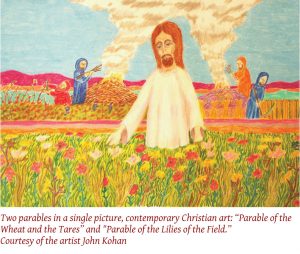 The lilies of the field have a reputation for neither toiling nor spinning (Matthew 6:28). But what exactly is this flower that Jesus singled out during his Sermon on the Mount?
The lilies of the field have a reputation for neither toiling nor spinning (Matthew 6:28). But what exactly is this flower that Jesus singled out during his Sermon on the Mount?
In the past, some believed it was the rose of Sharon from the Song of Songs, others argued it was the white Madonna lily (Lillium). The consensus today identifies the lily of the field as the crown anemone (Anemone Coronaria), a flower associated with the Crucifixion in various traditions.
Some representations of the Crucifixion depict clusters of anemones growing close to or even right under the cross. One belief even holds that the flowers derive their fiery, blood-red color from the blood of Christ dripping down the crucifix onto the earth below.
In Israel, anemones flower during the rainy season and blossom until March or April. During their brief flowering, they carpet entire swathes of the land of Israel a deep fiery red, making “flower peeping” a seasonal national pastime with hundreds of thousands of people descending on the northern Negev to see the blooms.
If you go anemone viewing, make sure you are looking at the right flower and not a seasonal lookalike. It’s easy to confuse the crown anemone with other red flowers, including the Persian buttercup (Ranuculus asiaticus) and the Semitic poppy (Papaver umbonatum) that blossom around the same time.
The easiest way to distinguish between them is to count their petals. The crown anemone usually has six, the Persian buttercup five and the Semitic poppy four. But to make sure nature is not playing a trick on you, you need to look a little closer.
Once the crown anemone has been pollinated (by beetles and not by bees or other insects), it develops a white ring at the base of its petals. The poppy develops black spots and the Persian buttercup’s petals stay fiery red.
Given the sheer quantity of flowers that can be seen today, it’s hard to believe this little wildflower was once so loved it was nearly picked into extinction. Thankfully, a law was passed in the 1960s that prohibits picking anemones and other wildflowers, such as the cyclamen, leaving them to be enjoyed in their natural setting, neither toiling, nor spinning, for generations to come.
Find out more in Sacred Flowers, Holy Trees & Blessed Thorns: Fifty Plants in the Life of Jesus by Ami Tamir
By Danielle Max

